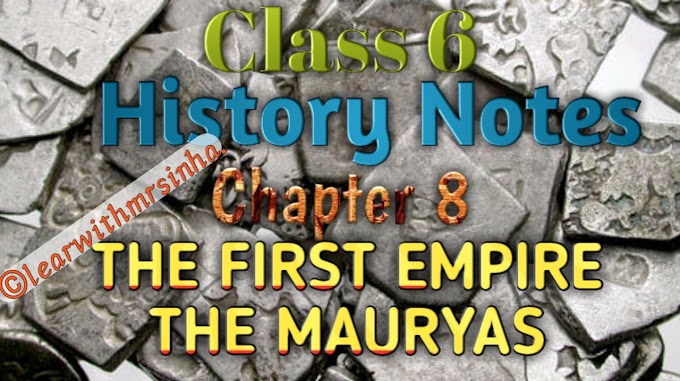History Notes
Class 6
4. The First
Cities
In the Indian subcontinent, the first cities came into being in the valley of River Indus(INDUS VALLEY CIVILIZATION). They were Harappa and Mohenjo-daro (Both are now in Pakistan). This is why archaeologists and historians have named this culture as the ‘Indus Valley Civilization’ or ‘Harappan Civilization’.
Harappa was first excavated by Rai Bahadur Daya Ram Sahni in 1921 and,
Mohanjo-daro by "Rakhal Das Banerji" in 1922. (Rakhal das was actually excavating the ruins of a Buddhist temple.
The civilization flourished between 2500-1500 BC, that is, about 3,500-4,500 years ago.
Indus Valley civilization was spread over large part of present-day Pakistan and the Indian states of Punjab, Haryana, Uttar Pradesh, Rajasthan and Gujarat.
Main Sites :-
Harappa and Mohanjo-daro are most important sites and twin capitals.
others,
Cities of the Civilization :-
- Cities were well planned.
- Streets cut each other at 90*
- In Mohanjo daro the main street was over 800 m long and 10 m wide.
- Baked bricks were used to construct buildings.
Most Cities are divided into two parts -
1. Citadel or Acropolis :-
Built on raised ground.
- High wall made up of baked bricks to protect during floods.
- Contains Public Buildings, Religious Structures and Granaries.
- Ruins of many buildings found there in Harappa and Mohanjo-daro.
2. Lower town :-
- Built at low height and much big area.
- It had small building and houses for common peoples.
- Houses were one or two storeys high.
- Houses had courtyard with rooms around it, a bathroom, a kitchen and a well-planned drainage system.
History Notes Class 6
The Citadle :-
- Ruins of many buildings found there in Harappa and Mohanjo-daro.
- Largest Building of Mohanjo-daro are granary (granaries).
- Mohanjo-daro also have Great Bath (a rectangular structure and resembles a swimming pool).
- It was perhaps used for bathing on special occasion.
The Lower Town :-
- Residential Building
- Houses were one or two storeys hight.
- House had Courtyard with rooms around it.
- A bathroom, a kitchen, a well, well panned drainage system.
Occupation and Crafts :-
- Farmers,Weavers, Potters, Jewellers, Metal workers, Toy makers, Stone cutters, Seal makers, Boat makers, Masons and Traders.
- Advance Pottery making - Beautiful reddish glazed, designing pottery.
- Seal of terracotta (Square and Rectangle) (Animal Picture, Sign)
- Craftsmen made things (stones, metal, seal) :- Beads, Amulets, Weights and Ornaments (ring, necklaces, bracelets, bangle, earrings).
- Terracotta toys (Animals, Birds, Doll)
- Clothes of Cotton and Wool.Obtained Needles ad buttons.
- Crops (Wheat and Barley are main crops) :- Rice, Pulses and Mustard.
- Domestic Cattle :- Buffaloes, Sheeps and Goats.
Trade :-
Copper, Tin, Gold, Silver and Precious Metals - Mesopotamia (Modern Iraq), Persia (Modern Iran), Oman and Afghanistan.
Over Sea Trade carried out on form Lothal, where a dockyard for ship has been found.
Script :- (Seals)
"It is the earliest form of writing discovered in India."
Script - Pictographic (Picture like sign representing words). It has not yet been deciphered.
Harappan Cities in Gujarat
Lothal :-
- Coastal site.
- Divided into Citadle and Lower town.
- Large warehouse were found (store goods).
- A bead factory (tools, finished & SemiFinished beeds), many mesopotamia seals and a brick dockyard found connected to the Gulf of Cambay by a channel.
- Lothal (port) was overseas trade.
Dholavira :- (Kotada) Excavatio started in 1990 , till now.
- Lies in the Khadir Island in the Rann of Kutch.
- In term of size, it is one of the largest Idus Settlement in India and fifth largest of the sites.
- Famous for its magnificent town planning.
- Divided into three parts :- a) A Citadel, b) A Middle Town and c) A Lower Town.
- Each part was enclosed by a stone wall.
- Many graves (contain pottery and jewellery) were found.
Dholavira is famous for the oldest signboard in the world, containing 10 large size signs of Harappan script. Unique because all other found in seals.
Science Notes Class 6
Gola Dhora :-
- Shell and Copper were produced here.
- Factory of Shell Bangles
- Recently excavated site in the Kutch region.
- Excavated shell and copper products (shell bangles)
- A seal has also been found, hollow and shaped like a box.
Decaline :-
- There may have been natural disasters such as earthquakes, floods, epidemics or a change in the course of River Indus.
Archeological evidence suggested that people abandaoned the cities and moved to small settlements.
In this blog of Class 6 social science (the first cities class 6) we learnt about sindh province, city of lothal, farmers or herders.







0 Comments